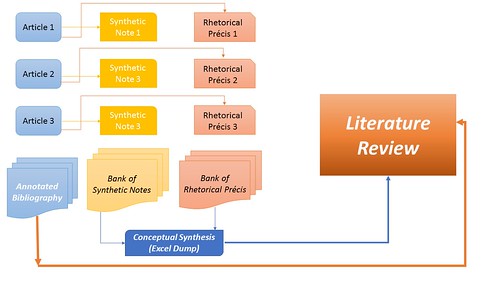One of the research products I find most useful for an academic, short of openly-accessible datasets and code for replication is the annotated bibliography. As I have noted before, I consider the annotated bibliography an intermediate step between a bank of rhetorical precis, a bank of synthetic notes, and a fully-developed literature review.
I consider developing annotated bibliographies an important activity. Thus the annotated bibliography is, for me, an actual scholarly product. It may come from “intermediate” materials, such as a set of rhetorical precis, or a group of synthetic notes, but in the end, the annotated bibliography is a scholarly product in and of itself. It should be readable and provide you with insight that you couldn’t get from the full set of articles or book chapters.
Generally speaking, you can see the annotated bibliography as an organized, systematic dump of all your synthetic notes (or rhetorical precis). Each entry starts with the full article, book or book chapter citation, followed by a short summary of the article. Some authors include the article or book chapter abstract, others don’t.
Here are two examples of excellent annotated bibliographies. The first one is on Indigenous water governance in Canada. The second, on community-based water governance, was created by Jingsi Jin with Kelly Sharp under Dr. Crystal Tremblay and Dr. Leila Harris’ supervision.
One element that links the rhetorical precis and the annotated bibliography is that in the annotation for each entry, you can make a value judgment as to what aspects you find more valuable or important of the article. When I write those judgments, I copy those notes (my synthetic notes) and insert them into my Conceptual Synthesis Excel Dump for that particular topic.
For example, I am currently writing on timing and sequencing (that is, on how specific events can lead to the creation of specific rules, norms and institutions). I could write an annotated bibliography on the topic (which I am not currently doing as I am writing a full paper, but it would be possible for me to do it as an intermediate step). Previously, I have written on how you can draw several of the most important ideas of a paper by looking at the Abstract, Introduction and Conclusion (the AIC method).
The AIC technique DOES NOT substitute for an actual, in-depth read of a paper. But it does provide some basic ideas for an annotated bibliography. You should also be able to write most of the synthetic summary for a paper out of the AIC summary. The AIC also provides you with the foundations of a detailed memorandum.
Following the timing and sequencing example, I am reading Tulia Falleti’s “A Sequential Theory of Decentralization” APSR paper. In this paper, Professor Falleti proposes that the timing and sequencing of decentralization implementation have an impact on how intergovernmental relations result and what the specific outcome in this process will be. While the entire paper is important, I am mostly interested in the timing and sequencing components.
My annotated bibliography entry could very well just include a summary of the main points of Falleti’s paper:
Falleti, Tulia G. “A sequential theory of decentralization: Latin American cases in comparative perspective.” American Political Science Review 99.03 (2005): 327-346.
In this paper, Falleti proposes a sequential theory of decentralization where she defines decentralization as a process, looks at the sequence of events that decentralization processes follow, defines three types of decentralization and takes into account policy feedback effects and the territorial interests of bargaining actors. Falleti applies her analysis to four Latin American countries. Falleti shows that decentralization doesn’t necessary increase the power of governors and mayors, but instead this power is dependent on the sequence of decentralization reforms and the timing of these.
Normally, for papers I am reading at the overview/meso level, I would write a summary that is based on the results of AIC (Abstract, Introduction, Conclusion). However, since I find this article by Tulia Falleti quite important, I will write a detailed memorandum, and I will drop my highlights and scribbles on the margins into my Excel dump (Conceptual Synthesis).
From the article’s conclusions I draw the ones that I’m most interested in (sequencing of decentralization reforms) pic.twitter.com/TSBfwEMH4Y
— Dr Raul Pacheco-Vega (@raulpacheco) April 28, 2017
As I have written before, I triage the full set of readings I plan to do, and I am strategic, focusing in more depth on those articles, books and book chapters that I know could very well provide me with key insights for a literature review. Being this strategic isn’t all that relevant if one is doing a very broad annotated bibliography. That’s why doing a citation tracing process around anchor authors is important. You need to make sure that you do in-depth readings when those are written by the key authors that you need to read for your literature review.
Hopefully sharing my processes will help people write their annotated bibliographies and their literature reviews!




Found your blog at the perfect time. First-year PhD student struggling with literature reviews.